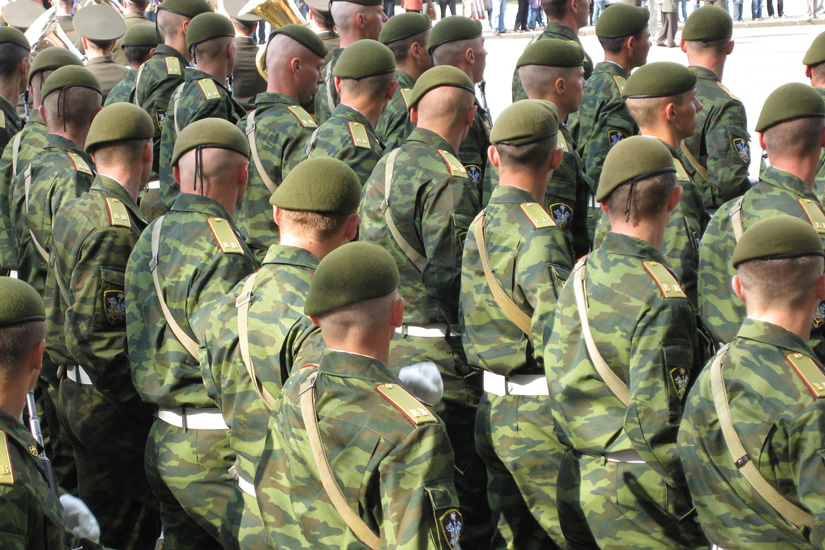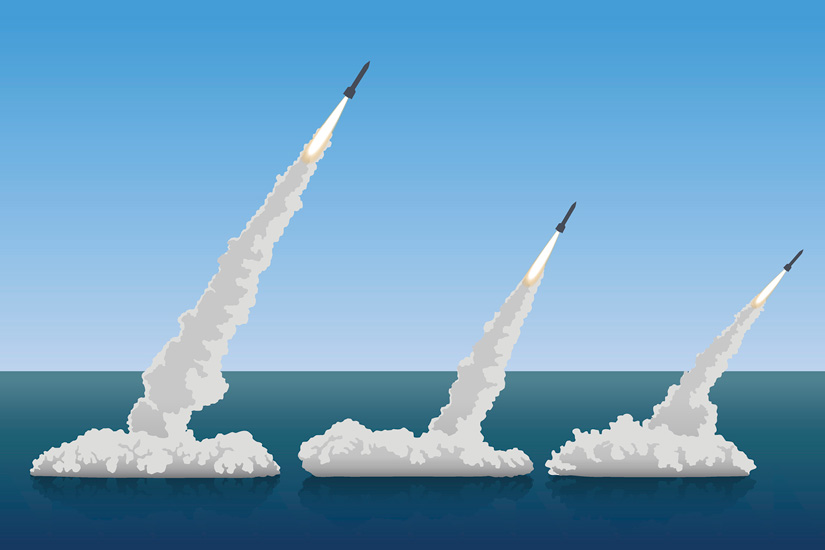The Russian military has undergone a series of profound transformations over the course of its history, from the nineteenth-century reforms of Dmitry Milyutin, who laid the foundation for the modern Russian army, to the creation of the Soviet Red Army under Leon Trotsky and the development of nuclear missiles during the Cold War. For better or worse, Russia’s place in world history has largely been defined by its military endeavors.
The twenty-first century appears to be no exception. On February 24, 2022, Russia launched a full-scale invasion of Ukraine, employing military force to disrupt the international order. Since then, it has continued to expand and reconfigure its capabilities, particularly along the European front. Many ground forces from the Far East have reportedly been redeployed to Ukraine, but other contingents around Japan—most notably nuclear submarines—appear to be growing. This article examines the current state and future outlook of the Russian military in the light of these developments.

The Status Quo
As of early 2025, Russia’s armed forces are estimated to number approximately 1,134,000 troops.[1] According to the 2025 edition of The Military Balance, published annually by the International Institute for Strategic Studies, this marks an increase of 234,000 compared to the prewar estimate of 900,000—roughly equivalent to adding the entire Japanese Self-Defense Forces.
When Vladimir Putin became president in 2000, he initially focused on downsizing the armed forces and curbing defense spending. This policy gradually retreated, however, with a series of military engagements, such as the 2008 war with Georgia, the invasion and annexation of Crimea and the seizure of the Donbas region in 2014–15, and the military intervention in Syria beginning in 2015. Downsizing attempts came to full stop with the start of the current war in Ukraine, which prompted a full-scale expansion of the armed forces.
Table 1 shows how Russia’s 1.13 million troops are distributed. The Russian Ground Forces (SV) claims the largest share with an estimated 550,000 personnel—nearly double the prewar figure of 280,000. The increase likely reflects the brutal war of attrition in Ukraine, where sheer manpower and firepower have become decisive factors. The Ministry of Defense has reportedly been recruiting 400,000 to 500,000 contract soldiers (volunteers) annually since the start of the war,[2] fueling the army’s growth. But the fact that such large-scale recruitment has resulted in a net gain of just 270,000 also highlights the staggering human cost of the war.[3]
Meanwhile, elite units have suffered significant attrition. The Russian Naval Infantry has declined from 35,000 troops before the war to just 10,000, while the Russian Airborne Forces (VDV)—a separate combat arm—have shrunk from 45,000 to 35,000. These figures suggest the difficulty of maintaining full-strength elite units under prolonged wartime conditions.
The Russian Aerospace Forces (VKS), responsible for aerial operations, have seen only modest growth. Between 2021 and 2025, the number of operational aircraft increased slightly from 1,160 to 1,224, while personnel grew from 165,000 to 170,000. However, frontline Su-25 attack aircraft declined from 194 to 161, and Su-34 fighter-bombers also suffered heavy losses. According to Oryx—a website tracking equipment losses based on visual evidence—Russia lost 136 fixed-wing aircraft and 152 helicopters over the past three years.[4] The air war has clearly been no less punishing than the ground campaign. (It is also worth noting that Ukrainian air power has long been depleted, underscoring the strategic value of Western-supplied aircraft, such as F-16s and Mirages.)
The Russian Navy (VMF) has perhaps been hit hardest. Its personnel declined from 150,000 in 2021 to 119,000 in 2025. This likely reflects not only losses in the aforementioned Russian Naval Infantry but also sustained damage to the Black Sea Fleet. Over the past three years, Ukraine has destroyed three surface combatants, including the flagship Moskva (a Project 1164 Slava-class cruiser), as well as a Project 636.3 diesel-electric submarine and four large landing ships—all while in port. In 2024, both the fleet’s main and backup command centers came under attack, and numerous naval officers are believed to have been killed over the course of the war.
Table 1. Composition of the Russian Armed Forces, 2021–25
| 2021 | 2025 | ||
|---|---|---|---|
| Total Personnel | 900,000 | 1,134,000 | |
| Service Branches | Ground Forces (SV) | 280,000 | 550,000 |
| Navy (VMF) | 150,000 | 119,000 | |
| Aerospace Forces (VKS) | 165,000 | 170,000 | |
| Independent Branches | Airborne Forces (VDV) | 45,000 | 35,000 |
| Strategic Rocket Forces (RVSN) | 50,000 | 50,000 | |
| Directly under General Staff | Special Operations Forces (SSO) | 1,000 | 1,000 |
| Directly under Ministry of Defense | Railway Troops (ZhDV) | 29,000 | 29,000 |
| Command and Support | 180,000 | 180,000 |
Source: Compiled by the author from various editions of IISS, The Military Balance.
Future Outlook for Conventional Forces
In response to these challenges, Russia has pursued both the expansion and qualitative transformation of its conventional forces. A new blueprint was announced in December 2022, when then Defense Minister Sergey Shoigu presented a plan at the expanded meeting of the Ministry of Defense Board.[5] He cited the prolonged attritional war in Ukraine and the need to bolster defenses in the northwest following Sweden’s and Finland’s accession to NATO as justifications for a large-scale military build-up.
Shoigu’s plan called for increasing total military personnel from just over 1.01 million to 1.5 million (including 695,000 contract soldiers), a 50% increase. It included the formation of three new mechanized infantry divisions in Kherson and Zaporizhzhia, an army corps in Karelia, and the conversion of seven brigades in the Western, Central, Eastern, and Northern Fleet military districts into full-fledged divisions. Two helicopter air assault divisions were to be added to the Airborne Forces, while five new Naval Infantry divisions would be formed from existing brigades. The emphasis was not just on numerical growth but on reorganization into heavier, division-based formations.
Shoigu also announced plans for the same number of mixed aviation divisions and army aviation brigades (with 80–100 helicopters) to be deployed as a combined arms (tank) army, along with the formation of five artillery divisions and high-power artillery brigades as artillery reserves, highlighting a push to bolster support forces.
Another notable element was Shoigu’s proposal to redraw the boundaries of Russia’s military districts. Under the new scheme, the Moscow and Leningrad military districts would oversee operations on the European front. Additionally, the regional joint operational commands introduced over the past 15 years would be abolished. Operational control would revert to the individual service branches—a return to the Soviet-era system in which each service acted as a distinct operational force.
These directions were reaffirmed at the December 2024 expanded board meeting, where newly appointed Defense Minister Andrei Belousov outlined the medium-term outlook.[6] Belousov warned of a possible large-scale conflict with NATO within the next decade and argued that the Russian military must be structured accordingly, regardless of the eventual outcome in Ukraine. The implication was clear: the armed forces would continue building a large-scale, conventional force capable of waging a major war against NATO.
The Modernization of Strategic Forces
On the other hand, there has been little expansion of the Strategic Rocket Forces (RVSN), responsible for operating Russia’s intercontinental ballistic missiles. Personnel, estimated by the Military Balance to be around 50,000, has remained largely unchanged from prewar levels. This is not surprising, given the RVSN’s lack of involvement in the fighting. It still comprises 11 rocket divisions and 1 communications division, and the number of deployed ICBMs has held steady at around 330.[7]
That said, Russia has been moving to modernize its strategic nuclear arsenal by replacing older ICBMs with newer models. According to RVSN Commander Sergei Karakaev, 21 ICBM regiments—16 of them mobile—underwent modernization over the past decade. As a result, the Soviet-era RS-12M Topol has been fully retired.[8] The newer RS-24 Yars missile has become the backbone of the ground-based strategic force, with over 200 launchers deployed in both mobile and silo-based configurations. Several variants of the Yars, including the Yars-S and Yars-M, are believed to be in service.
Deployment of the Avangard system featuring hypersonic glide vehicles is also slowly moving forward, with two regiments reportedly being formed under the 13th Orenburg Rocket Division.[9] Meanwhile, development is underway on a new ICBM known as Osina, expected to eventually replace the Yars series.
The Russian Navy’s strategic submarine fleet is also being upgraded. While the number of nuclear-powered submarines capable of launching ballistic missiles (SSBNs) remains unchanged at around 11 or 12, older models like Project 667BDR (Delta III-class) and Project 667BDRM (Delta IV-class) are being phased out in favor of newer vessels, such as Project 955 Borei and Project 955A Borei-A. More than half of the current SSBN force now consists of post–Soviet vessels, and future upgrades are expected to include Project 955AM Borei-AM, primarily in the Northern Fleet.
Strategic bombers, however, remain a weak link. The development of next-generation PAK-DA stealth bombers has been slow, and the existing fleet is aging and shrinking. That said, efforts continue to be made to modernize and extend the life of existing aircraft, and production of the Tu-160 has resumed—though at a sluggish pace. In the near term, then, an abrupt decline in the size of the bomber force is unlikely. All in all, Russia will likely maintain its strategic nuclear forces at current levels in quantitative terms while seeking qualitative modernization.
Table 2. Composition of Russia’s Nuclear Forces, 2021–24
| 2021 | 2024 | ||
|---|---|---|---|
| ICBMs | RS-12M Topol (SS-25) | 27 | 0 |
| RS-12M2 Topol-M (SS-27 Mod 1) | 78 | 78 | |
| RS-20V Voyevoda (SS-18 Mod 6) | 46 | 34 | |
| RS-24 Yars (SS-27 Mod 2) | 155 | 204 | |
| RS-28 Sarmat (SS-X-29) | 0 | 0 | |
| Avangard (SS-19 Mod 4) | 4 | 10 | |
| SSBNs | 667BDR class | 1 | 0 |
| 667BDRM class | 6 | 5 | |
| 955 class | 3 | 3 | |
| 955A class | 1 | 4 | |
| Strategic Bombers | Tu-95MS/MSM | 55 | 52 |
| Tu-160/M/M2 | 13 | 15 |
One area of uncertainty is the delay in the RS-28 Sarmat program, Russia’s next-generation heavy ICBM. As the aging RS-20V Voyevoda missiles are retired, a delay in introducing the Sarmat could temporarily reduce Russia’s ground-based strategic warhead count. An explosion during a test launch of a Sarmat ICBM at Plesetsk in 2024 highlighted reliability issues that could further postpone deployment.
Another risk factor is the RVSN’s apparent deployment of intermediate-range ballistic missiles. In November 2024, Russia used a new ballistic missile called Oreshnik in a strike against Ukraine. Russian announcements describe it as a conventional IRBM to be operated by the RVSN. There are plans for it to be forward deployed to Belarus, but details on the scale and configuration of deployment are as yet unclear. It goes without saying that if it were converted to carry nuclear warheads, it could also function as a tactical nuclear weapon.
Conclusion
The changes described above suggest that the Russian military is undergoing a long-term, qualitative transformation. One of the key questions moving forward is whether the United States will maintain its commitment to European defense. If not, much will depend on the scale and substance of European countries’ own defense efforts. These factors will, in turn, determine the credibility of efforts to deter further Russian aggression, even as efforts toward a ceasefire in the Ukraine war continue.

(2025/04/30)
Notes
- 1 IISS, The Military Balance 2025, Routledge, 2025, p.180.
- 2 For example, regarding the number of recruits for 2023, then-Defense Minister Sergei Shoigu cited a figure of 540,000. “Сергей Шойгу: операция по Авдеевке войдет в учебники,” TASS, February 21, 2024. Meanwhile, during the expanded leadership council of the Russian Ministry of Defense held in December 2024, Minister Andrei Belousov revealed that the number of volunteers recruited in 2024 (likely by November) was 427,000.
- 3 A well-known joint tracking project by Mediazona and the BBC covers Russian combat fatalities. According to the project, the number of deaths confirmed as combat fatalities was just under 96,000 by the end of February 2025, while the total estimated number of combat-related deaths, based on population dynamics, is thought to be as high as 165,000. “Russian Losses in the War with Ukraine. Mediazona Count, Updated,” Mediazona, accessed March 12, 2025.
- 4 “Attack on Europe: Documenting Russian Equipment Losses During the Russian Invasion of Ukraine,” Oryx, accessed March 12, 2025.
- 5 This is available on the official Russian Ministry of Defense website, but due to security reasons, the URL is not provided here as it leads to an unsecured link.
- 6 For the same security reasons, no link is provided here.
- 7 Hans M. Kristensen, Matt Korda, Eliana Johns, and Mackenzie Knight, “Russian Nuclear Weapons, 2024,” Bulletin of the Atomic Scientists, 2024, vol. 80, no. 2, pp.118–19.
- 8 “Надёжная опора безопасности и суверенитета России,” Krasnaya Zvezda, December 17, 2024.
- 9 Ibid. Additionally, for large land-based rockets like Avangard, the standard composition of one missile regiment is said to be six missiles.

